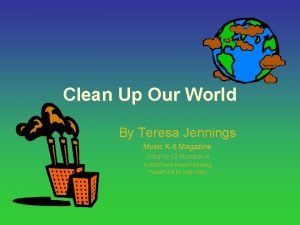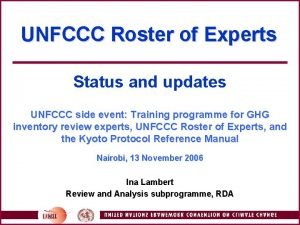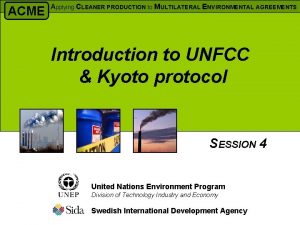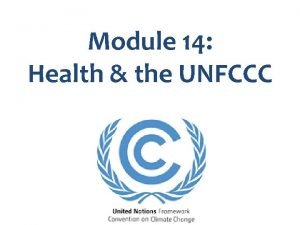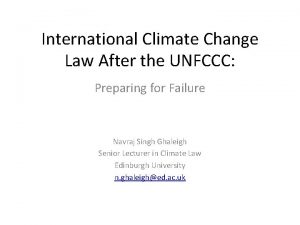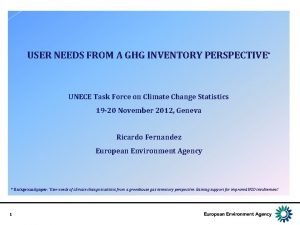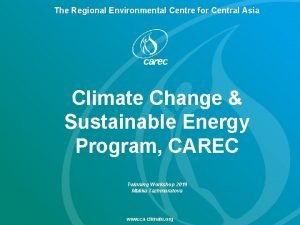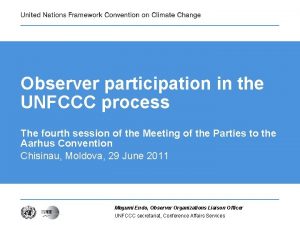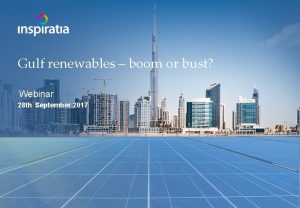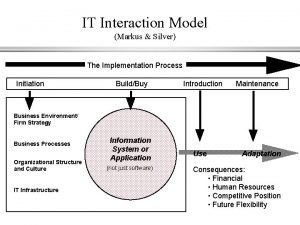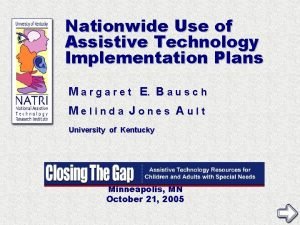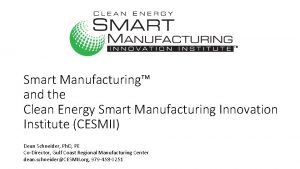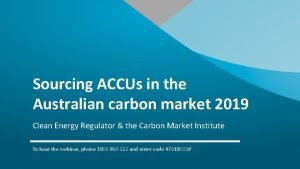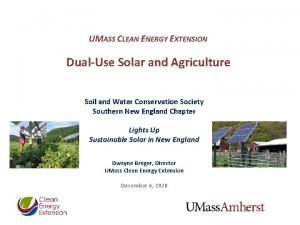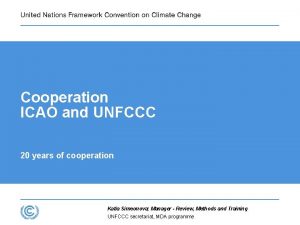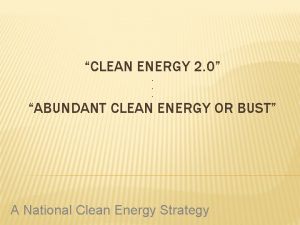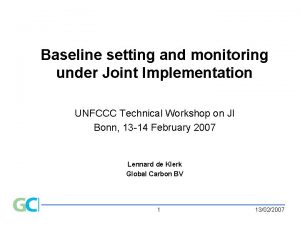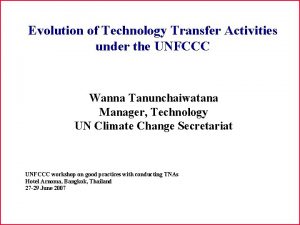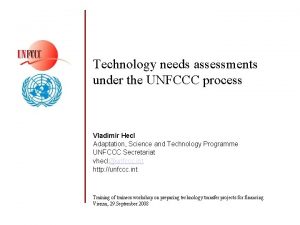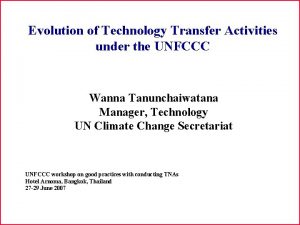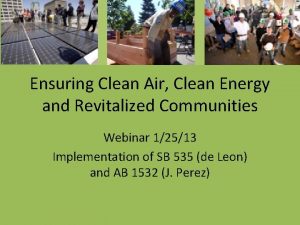Clean Energy Technology Cooperation under the UNFCCC Implementation

















- Slides: 17

Clean Energy Technology Cooperation under the UNFCCC: Implementation Approaches Ron Benioff (NREL), Subash Dhar (Risoe National Lab), Heleen de Coninck (ECN), Jyoti Painuly (Risoe National Lab), Ulrich Hansen (Risoe National Lab) and Joyce Mc. Laren (NREL) Draft Paper December 11, 2009 National Renewable Energy Laboratory Innovation for Our Energy Future

Paper Provides Concrete Implementation Examples and Steps Objectives • Identify potential implementation elements and structures for clean energy technology programs under the UNFCCC building on successful models • Suggest key steps for launching and managing such programs Focused on Three Key Elements of Clean Energy Technology Cooperation • Research, Development, and Demonstration • Enabling Environments • Financing National Renewable Energy Laboratory Innovation for Our Energy Future

Evaluated Implementation Approaches for Three Options in Each Area Research and Development RD&D Networks and Road Mapping Enabling Environments Financing National Policies Investment Matchmaking and Advisory Services Multilateral R&D Collaboration International Cooperation on Sectoral Deployment Programs Coordination of Existing Funds Technology Demonstration Partnerships Technology Access and Investment Risk Mitigation Intellectual Property Rights National Renewable Energy Laboratory Innovation for Our Energy Future

Review of Implementation Attributes of Existing Programs Program Country Plans + Strategi es TT: CLEAR √ GEF √ Building RD+D Enabling Cooper Environm ation ents & Capacity All Groups of Developi ng Countries Coordina ted Program s Across Donors √ √ √ CDM APP + MEF Financi Long-Term Private ng Partnershi Sector Facilita ps Engage tion ment √ √ √ MDB + UN Programs √ √ √ Bilateral Programs √ √ IEA √ Technology Agencies + Partnerships √ √ √ CTI √ √ √ √ National Renewable Energy Laboratory Scale for Large Global Impacts √ √ √ Knowledge Sharing Across Countries √ √ √ Innovation for Our Energy Future

Potential RD&D Cooperation Framework Researcher Exchange and Training Programs Strengthen Regional Centers & Networks Expert Networks Technology Networks. Global and Regional Technology Standards, Testing, & Certification and Training Programs Portals with RD&D Data, Methods, and Tools Technology Roadmaps & Action Plans – Global, Regional, and National R&D Cooperation Joint R&D Solicitations Emerging Technology Demonstration Programs Multilateral and Bilateral R&D Projects National Renewable Energy Laboratory Demonstration Partnerships Expanded Developing Country Demonstrations Innovation for Our Energy Future

Example of Implementation Responsibilities for Global Clean Energy RD&D Cooperation Coordination with Bilateral Programs UNFCCC Clean Energy Technology Cooperation Advisory Group Implementing Agencies or Partnerships Technology Networks Global Energy Agencies Bioenergy National Renewable Energy Laboratory Buildings Partnerships Clean Coal e. g. GEF, MDBs, and UN Agencies Solar Wind Others Innovation for Our Energy Future

Conclusions on RD+D Cooperation • RD&D Cooperation May be Most Effectively Implemented by Technology Partnerships along with Bilateral Programs • A Clean Energy Technology Advisory Group and Designated Implementing Agencies Can Guide the Work of these Partnerships • Shared RD&D Technology Roadmaps Can Drive Program Design • Multilateral R&D Projects Can Occur Via Partnering on Independently Funded Projects and Through Joint Solicitations • Technology Demonstration Partnerships Can be Implemented in Parallel with Expanding Demonstrations in Developing Countries National Renewable Energy Laboratory Innovation for Our Energy Future

Enabling Environments • Context: Effective cooperation on building enabling environments not only will mobilize technology investment, but can also build trust between developed and developing countries • Creating enabling environments requires – National Policies – International Collaboration – Access to Technology • National Policies – Are the main driver for technology transfer and diffusion, by reducing market risks, providing incentives for technology investment, and building demand public support – National Policies should be linked with NAMAs and NAPAs and considered in context of long-term climate and development goals – TNA are a key element of enabling activities leading to NAMAs and NAPAs National Renewable Energy Laboratory Innovation for Our Energy Future

International Collaboration & Technology Access • International Collaboration for National Sectoral Deployment & Diffusion – Target specific technologies or sectors – Build capacity of public institutions, governmental agencies and private sector – Align with national development priorities and NAMAs – Transfer process may involve - Bilateral / Multilateral , financial/technical/both, public institutions / private sector • Access to Technology – Both hardware as well as software – Technology access more of an issue for LDCs, with diversity of views across all countries on role of IPR – Increase capacity to adapt, absorb and develop technologies through workforce development and upgrading educational and research infrastructure – Replicate successful experiences with technology cooperation that occur through sustained and focused public-private cooperation National Renewable Energy Laboratory Innovation for Our Energy Future

Conclusions on Enabling Environments • Strong National policies essential to create conducive opportunities for technology deployment. • International coordinated programs targeting specific sectors should be expanded to foster capacity building and to establish focused technology diffusion plans. • Access to technology should – Replicate successful models of sustained cooperation between countries and with private sector on specific technologies – Build national capacities to adapt, absorb and develop technologies through workforce development and up-grading educational and research infrastructure National Renewable Energy Laboratory Innovation for Our Energy Future

Financing Challenge: make sense of the finance challenge • Incremental costs or investment? • Top-down gap or mix of bottom-up barriers? • Leveraging ratios or tailor-made instruments? Starting points: • Financing challenges is not simply put in terms of the financial gap – heterogeneous, • A fund that provides a “ 1: 20 leveraging ratio” does not exist • Diverging from the bad to the good in an efficient manner National Renewable Energy Laboratory Innovation for Our Energy Future

Financing Common barriers Gap between financial and policymaking/ innovator community Lack of insight in current spending and potential for change Perceived risk of clean technology investments in developing countries Matchmaking and advisory services Coordination of existing funds Investment risk mitigation vehicles Private Financing Advisory Network (PFAN) Potential for scale-up? EGTT finance options report Ability to coordinate United States Overseas Private Investment Corporation (OPIC) What mechanism really works in which conditions? Addressing challenges through facilitative mechanisms National Renewable Energy Laboratory Innovation for Our Energy Future

Conclusions on Financing Experimentation is necessary to get more insight in what works under which circumstances – We have a myriad of experiences in combination with an uncertain future – Don’t expect to get it right the first time One single fund for clean technology is unlikely to be manageable – Think delivery of finance to technology in country funds – Cannot be seen in isolation from the mitigation and technology discussions Focus public financing instruments on risk, not incremental costs – The gap becomes less daunting – More suited to financial sector National Renewable Energy Laboratory Innovation for Our Energy Future

Take Home Messages • Technology RD&D, enabling environments and finance programs should be conducted in combination • Strong national plans with stakeholder buy-in, along with shared global and regional technology roadmaps, can drive international cooperation. • Technology networks and partnerships, engaging the private sector, can play a central implementation role • Try - Learn – Decide – Deploy: allow experimentation to see what works • Coordination of international programmes of high value in improving impact and efficient resource use National Renewable Energy Laboratory Innovation for Our Energy Future

International Clean Energy Analysis Gateway • Web Portal to Support Developing Country Clean Energy Assessments • • • Clean Energy Potential Project Screening and Design Energy System Modeling Financing Options Many More Topics • Information on Tools & Resources from Around the World • Virtual Training and Forums • Sponsored by U. S. DOE and UNIDO • Interested in Expanding Partnerships Gateway Design Expert and International Networks Analysis data, tools and methods Web forums and community exchanges Users On-line training and resources www. openei/icea National Renewable Energy Laboratory Innovation for Our Energy Future

CLEAN - Coordinated Low Emission Assistance Network • Network to Coordinate and Improve Assistance to Developing Countries for Low Carbon Plans and Technology Needs Assessments, Roadmaps, and Deployment Programs • Activities • • • Common Principles Methods Development Collaborative Training and Technical Assistance Coordinated Country Support Knowledge Sharing Linkage with Other Organizations • Inviting Organizations with Similar Programs to Join • Contact – ron. benioff@nrel. gov National Renewable Energy Laboratory Founding Members • Energy research Center of the Netherlands (ECN) • German Aerospace Center (DLR) • German Technical Cooperation (GTZ) • International Energy Agency (IEA) • Joint Implementation Network (JIN) • United States National Renewable Energy Laboratory (NREL) • United Nations Environment Program (UNEP) • UNEP Risø Center on Energy, Climate and Sustainable Development (URC) • United Nations Industrial Development Organization (UNIDO) Innovation for Our Energy Future

The Lab Consortium: Accessing Clean Energy Tools, Data, and Expertise across U. S. National Laboratories Goal: Ensure that U. S. technical resources can be readily accessed to support global efforts to combat climate change Activities: Targeted technical assistance in response to country partner needs drawing upon National Lab expertise, tools, and models Sponsors: USAID and U. S. DOE Examples of tools and capabilities at: http: //openei. org/uslabs National Renewable Energy Laboratory Innovation for Our Energy Future
 Clean up everybody let's clean up
Clean up everybody let's clean up Unfccc roster of experts
Unfccc roster of experts Unfccc annex 1 countries
Unfccc annex 1 countries Unfccc
Unfccc Unfccc
Unfccc What is this picture
What is this picture Unfccc 2020
Unfccc 2020 Megumi endo unfccc
Megumi endo unfccc Unfccc 2020
Unfccc 2020 It interaction model in mis
It interaction model in mis National assistive technology research institute
National assistive technology research institute Clean energy smart manufacturing innovation institute
Clean energy smart manufacturing innovation institute Renewable energy source definition
Renewable energy source definition Accu spot price
Accu spot price Umass clean energy extension
Umass clean energy extension Retscreen manual
Retscreen manual Fe clean energy
Fe clean energy Clean energy project analysis
Clean energy project analysis
